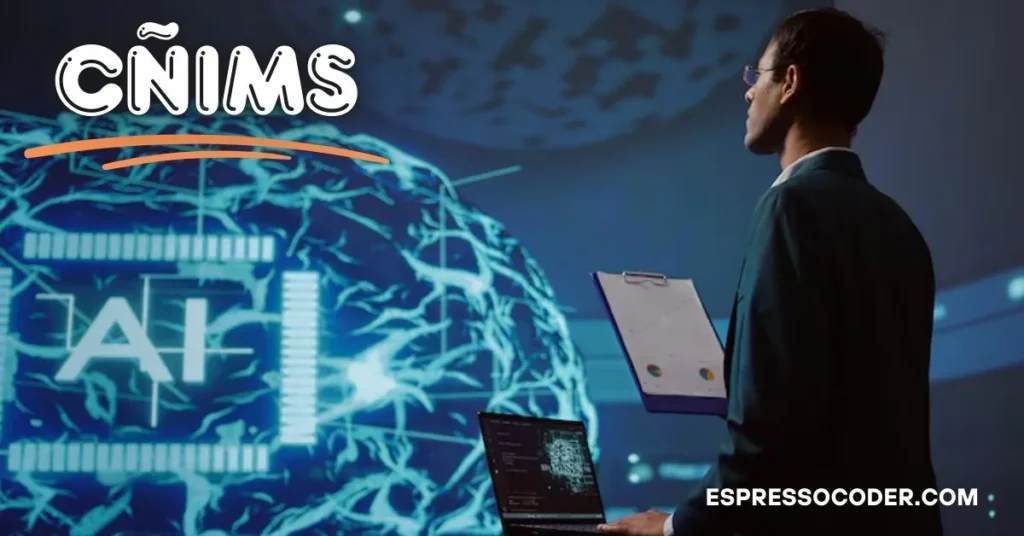Contents
Introduction:CÑIMS
CÑIMS (Cognitive Neural Integration Management System) is an advanced system designed to enhance data processing and predictive analytics. By combining cognitive computing with neural networks, CÑIMS offers more accurate insights and decision-making capabilities. It streamlines data integration, improves pattern recognition, and adapts to evolving trends. Industries like finance, healthcare, and retail benefit from it.
| Aspect | Fact | Figures |
|---|---|---|
| Core Concept | Combines cognitive computing with neural networks for advanced data processing | Revolutionizes decision-making and data insights |
| Key Components | – Cognitive Processing Units (CPUs) – Neural Network Integration Layer – Data Harmonization Engine – Predictive Analytics Suite – Adaptive Learning Mechanisms | Mimics human cognitive functions and optimizes machine learning |
| Data Processing Features | – Data Standardization – Semantic Analysis – Anomaly Detection – Data Enrichment | Processes diverse data types from multiple sources in real-time |
| Pattern Recognition | – Complex Correlations – Temporal Patterns – Causal Relationships | Detects subtle relationships and evolving patterns across large datasets |
| Predictive Analytics | – Multi-Model Ensemble – Dynamic Feature Selection – Temporal Dependency Modeling – Uncertainty Quantification | Improves forecasting accuracy by combining predictions from multiple models |
| Real-Time Adjustments | – Model Retraining – Incremental Learning – Concept Drift Detection | Adapts predictions with real-time data updates |
| Explainable AI | – Feature Importance – Decision Path Visualization – Counterfactual Explanations | Enhances transparency of predictive models for users |
| Applications in Industries | Finance, Healthcare, Retail, Energy, Manufacturing, E-Commerce | Transforms operations in risk management, fraud detection, personalized services, etc. |
| Challenges in Implementation | – Data Quality and Availability – Technical Infrastructure – Skilled Workforce – Ethical Considerations | High-quality data, scaling resources, training staff, addressing bias and regulatory needs |
| Future Developments | – Integration with Quantum Computing – Advanced NLP – Emotion and Sentiment Analysis – Autonomous Decision-Making | Expected to expand in areas like quantum computing and emotional intelligence |
Revolutionizing Data with CÑIMS: Advanced Analytics & Predictions
The world of data science and artificial intelligence is rapidly evolving, with advancements that promise to reshape industries across the globe. One such breakthrough is CÑIMS, which stands for Cognitive Neural Integration Management System. CÑIMS is an innovative system designed to combine the strengths of cognitive computing and neural networks, making data processing and predictive analytics more powerful and efficient. It addresses the growing need for advanced data interpretation and decision-making by enhancing both human-like reasoning and machine learning.
In essence, CÑIMS aims to bridge the gap between how humans reason and how machines learn. By integrating cognitive principles with sophisticated neural network structures, CÑIMS offers a seamless and adaptive system that continuously improves its ability to analyze vast amounts of data. This allows organizations to unlock deeper insights and make more informed decisions in real-time. From improving operational efficiency to enabling better customer experiences, CÑIMS is revolutionizing how businesses leverage data. Its applications span numerous sectors, including finance, healthcare, retail, and energy, making it a game-changer for organizations looking to stay ahead in an increasingly competitive world.
Key Components of CÑIMS
- Cognitive Processing Units (CPUs)
Mimic human cognitive functions, helping the system to make decisions like a human brain. - Neural Network Integration Layer
Links neural networks with cognitive units for advanced processing capabilities. - Data Harmonization Engine
Standardizes and reconciles data from various sources to ensure consistency. - Predictive Analytics Suite
Uses machine learning algorithms to provide forecasts and trend analyses. - Adaptive Learning Mechanisms
Continuous improvement systems that optimize CÑIMS’ performance over time.
How CÑIMS Enhances Data Processing
CÑIMS redefines how organizations process and interpret data by combining cognitive computing and neural networks. This integration allows for a more advanced understanding of complex data sets, which traditional methods often miss. Key elements that make this possible include the following:
Streamlined Data Ingestion
CÑIMS stands out by efficiently processing large volumes of data from diverse sources.
- Data Standardization
Automatically converts incoming data into a consistent structure for easier analysis. - Semantic Analysis
Interprets the meaning behind data, ensuring it is contextually relevant. - Anomaly Detection
Identifies unusual patterns in real-time to flag potential issues early. - Data Enrichment
Adds contextual information to raw data, making it more actionable.
Advanced Pattern Recognition
By combining cognitive processing with neural networks, CÑIMS can detect patterns that traditional systems might miss.
- Complex Correlations
Detects subtle relationships between multiple data points. - Temporal Patterns
Recognizes time-based trends and patterns within data. - Causal Relationships
Identifies connections between unrelated data, providing new insights.
Contextual Data Interpretation
Unlike conventional systems, CÑIMS understands the broader context of data, improving decision-making.
- Historical Data Integration
Takes past data into account when making predictions. - Cross-Domain Insights
Applies knowledge from various fields to improve data interpretation. - Situational Awareness
Considers external influences like market trends or global events.
Predictive Analytics with CÑIMS
CÑIMS enhances forecasting by providing more accurate and reliable predictions.
Enhanced Forecasting Accuracy
CÑIMS improves prediction outcomes using multiple advanced techniques.
- Multi-Model Ensemble
Combines results from different algorithms to reduce prediction errors. - Dynamic Feature Selection
Automatically identifies the most important variables for predictions. - Temporal Dependency Modeling
Captures complex relationships between data over time. - Uncertainty Quantification
Provides confidence levels with predictions, giving decision-makers more clarity.
Real-Time Predictive Adjustments
CÑIMS can adjust its predictions based on real-time data inputs, allowing for more adaptive forecasting.
- Model Retraining
Continuously updates prediction models as new data is received. - Incremental Learning
Adapts predictions as data evolves, keeping forecasts relevant. - Concept Drift Detection
Identifies when changes in data patterns require model adjustments.
Explainable AI Integration
A key feature of CÑIMS is its explainable AI, which makes complex models more transparent.
- Feature Importance
Identifies which factors influence predictions the most. - Decision Path Visualization
Shows how predictions are made, helping users understand the model’s logic. - Counterfactual Explanations
Explains how changes in data would affect outcomes.
Applications of CÑIMS Across Industries
CÑIMS offers immense potential across a variety of industries, where its advanced data processing and predictive capabilities make a significant impact. Below are some of the key sectors benefiting from its capabilities:
Finance and Banking
- Risk Assessment
Helps banks identify potential risks and mitigate financial exposure. - Fraud Detection
Enhances the ability to spot fraudulent activities by recognizing unusual patterns. - Algorithmic Trading
Improves decision-making in trading by analyzing real-time market data. - Customer Segmentation
Provides insights into customer behavior, allowing for personalized services.
Healthcare
- Personalized Treatment Plans
Assists in designing treatments tailored to individual patients. - Disease Detection
Identifies early signs of diseases, improving diagnosis accuracy. - Drug Development
Speeds up the discovery and testing of new drugs. - Patient Flow Optimization
Helps hospitals manage resources effectively to improve patient outcomes.
Manufacturing and Supply Chain
- Predictive Maintenance
Anticipates equipment failures, allowing for timely repairs. - Inventory Optimization
Improves stock management and minimizes overstocking or stockouts. - Quality Control
Identifies defects early, reducing waste and improving product quality. - Risk Assessment
Helps supply chains become more resilient to disruptions.
Retail and E-Commerce
- Dynamic Pricing
Optimizes pricing strategies based on market conditions and demand. - Customer Behavior Analysis
Provides insights into shopping habits, enabling better customer targeting. - Personalized Marketing
Creates tailored marketing strategies to increase engagement. - Inventory Management
Enhances stock management by predicting demand trends.
Energy and Utilities
- Smart Grid Management
Optimizes energy distribution and reduces costs. - Energy Forecasting
Improves predictions of energy consumption patterns. - Predictive Maintenance
Reduces downtime of critical infrastructure with early fault detection.
Implementing CÑIMS: Challenges and Considerations
While CÑIMS holds immense promise, implementing it presents several challenges. Organizations must consider the following factors to ensure successful integration:
Data Quality and Availability
- Data Consistency
Ensure high-quality data for accurate processing. - Data Privacy
Adhere to security protocols and ensure compliance with privacy regulations. - Legacy System Integration
Overcome compatibility issues when integrating with existing infrastructure.
Technical Infrastructure
- Computational Resources
Ensure sufficient processing power to handle CÑIMS’ needs. - Real-Time Data Handling
Address the challenges of managing high-speed data streams. - Backup and Recovery
Implement systems to safeguard against data loss or system failures.
Skilled Workforce
- Training
Equip staff with the necessary skills to effectively use CÑIMS. - Cross-Department Collaboration
Encourage teamwork between data scientists and business experts. - Continuous Learning
Stay up-to-date with the evolving capabilities of CÑIMS.
Ethical Considerations
- Bias in Data
Address the risks of data bias affecting outcomes. - Transparency
Ensure clear, understandable decision-making processes. - Regulatory Compliance
Meet legal requirements, especially in sensitive industries.
The Future of CÑIMS
CÑIMS is poised to undergo exciting developments that will push its capabilities even further:
- Quantum Computing
Enhances processing speed and capacity. - Natural Language Processing
Improves interaction with users through better text comprehension. - Cross-Domain Knowledge Transfer
Expands the ability to solve problems across various fields. - Emotion and Sentiment Analysis
Incorporates emotional intelligence into data processing. - Autonomous Decision-Making
Makes real-time decisions with minimal human input.
Conclusion
CÑIMS is revolutionizing data processing and predictive analytics by combining cognitive computing and neural networks. Its ability to interpret complex data with context, accuracy, and adaptability provides businesses with powerful tools for informed decision-making. As industries continue to rely on data-driven strategies, CÑIMS is well-positioned to be a critical part of that evolution, unlocking new opportunities for innovation and growth.
FAQs
What is CÑIMS?
CÑIMS (Cognitive Neural Integration Management System) is an advanced system that combines cognitive computing and neural networks to enhance data processing and predictive analytics.
How does CÑIMS improve data processing?
CÑIMS streamlines data ingestion, harmonizes diverse data inputs, and uses cognitive processing to detect patterns, enabling more accurate insights.
What industries benefit from CÑIMS?
CÑIMS is beneficial across industries like finance, healthcare, retail, energy, and manufacturing, offering advanced predictive analytics and data-driven decision-making.
How does CÑIMS handle real-time data?
CÑIMS continuously updates predictions in real-time using incremental learning algorithms, concept drift detection, and model retraining.
What makes CÑIMS’ predictive analytics accurate?
CÑIMS uses multi-model ensemble techniques, dynamic feature selection, and uncertainty quantification to improve forecasting accuracy.
Is CÑIMS explainable?
Yes, CÑIMS includes explainable AI features such as feature importance analysis, decision path visualization, and counterfactual explanations to make its predictions transparent.
What challenges exist in implementing CÑIMS?
Challenges include ensuring data quality, scaling infrastructure, training staff, and addressing ethical considerations such as data bias.
What are the future developments for CÑIMS?
Future advancements include integration with quantum computing, improved natural language processing, emotion and sentiment analysis, and autonomous decision-making.

